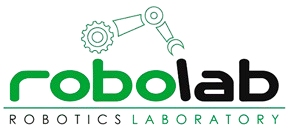Publicaciones
2024
- Barroso Ramírez, Zapata Cornejo, Nuñez Trujillo, Bustos García | Real-time Hazard Prediction in Connected Autonomous Vehicles: A Digital Twin Approach


- Pérez, Gerardo and Zapata-Cornejo, Noé and Bustos, Pablo and Núñez, Pedro | Social Elastic Band with Prediction and Anticipation: Enhancing Real-Time Path Trajectory Optimization for Socially Aware Robot Navigation


- Rebeca Marfil, Pablo Bustos, Antonio Bandera | Causal-Based Approaches to Explain and Learn from Self-Extension—A Review


- Torrejón Harto, Zapata Cornejo, Bonilla Rodríguez, Bustos García, Núñez Trujillo | Design and Development of Shadow: A Cost-Effective Mobile Social Robot for Human-Following Applications


- Torrejón Harto, Zapata Cornejo, Núñez Trujillo, Bonilla Rodríguez, Bustos García | Shadow, an accompanying tool robot


- Trinidad Barnech, Gonzalo Tejera, Valle-Lisboa, Núñez Trujillo, Bachiller Burgos, Bustos García | Enhancing Robotic Perception through Synchronized Simulation and Physical Common-Sense Reasoning


- Zapata, Noé and Pérez, Gerardo and Bonilla, Lucas and Núñez, Pedro and Bachiller, Pilar and Bustos, Pablo | Guessing Human Intentions to Avoid Dangerous Situations in Caregiving Robots


2023
- Barroso Ramírez, Bustos García, Núñez Trujillo | Towards a cyber-physical system for sustainable and smart building: a use case for optimising water consumption on a SmartCampus


- Montalbán Pozas, Lucas Bonilla, García Iglesias, Barroso Ramírez, Bustos García, Serrano Candela | Monitorización del consumo eléctrico a través de flujos de datos para la gestión inteligente y sostenible de edificios públicos


- Montalbán Pozas, Lucas Bonilla, Serrano Candela, Bustos García | A Methodology for Designing an Automated System to Improve the Thermal Performance of a Large Building in Operation


- Pérez González, Zapata Cornejo, Barroso Ramírez, Torrejón Harto, Bustos García, Núñez Trujillo | Follow me: interleaving human tracking and interacting with a new assistant robot


- Romero Garcés, Hidalgo Paniagua, Bustos García, Marfil Robles, Bandera Rubio | Inner Speech: A Mechanism for Self-coordinating Decision Making Processes in Robotics


- Sergio Eslava, María Segovia, Pablo Bustos, Pedro Núñez | The Galton Machine and the Quest for a Robotics Simulator


- Trinidad Barnech, Gonzalo Tejera, Valle Lisboa, Núñez Trujillo, Bachiller Burgos, Bustos García | Initial Results with a Simulation Capable Robotics Cognitive Architecture


- Zapata Cornejo, Barroso Ramírez, Torrejón Harto, Pérez González, Bustos García, Núñez Trujillo | Building a connected autonomous vehicle: design, construction and control


2022
- Duran, Vidarte, Vega, Bustos | A novel human-awarenss solution for person-following robots behavior problem based on proxemics


- Garcia Garcia, Núñez Trujillo, Bachiller Burgos, Bustos Garcia | Towards the design of efficient and versatile cognitive robotic architecture based on distributed low-latency working memory


- Pérez González, Rodríguez Domínguez, Bachiller Burgos, Bustos García, Núñez Trujillo | Introducing the Social Robot EBO: An Interactive and Socially Aware Storyteller Robot for Therapies with Older Adults


2021
- Bustos Garcia, Garcia, Cintas Pena, Martinena Guerrero | DSRd A Proposal for a Low-Latency Distributed Working Memory for CORTEX


- Calderita, Vega-Magro, Bustos Garcia de Castro, Núñez Trujillo | A new human-aware robot navigation framework based on time-dependent social interaction spaces An application to assistive robots in caregiving centers


- Manso Arguelles, Jorvekar, Faria, Bustos Garcia | Graph Neural Networks for Human-Aware Social Navigation


2020
- Araceli Vega, Calderita Estevez, Bustos Garcia, Núñez Trujillo | Human-aware Robot Navigation based on Time-dependent Social Interaction Spaces a use case for assistive robotics


- Bachiller Burgos, Barbecho Delgado, Calderita Estevez, Bustos Garcia | LearnBlock A Robot-Agnostic Educational Programming Tool


- Beatriz Montalban Pozas, Irene Amigo Gamero, Sanchez Dominguez, Bustos Garcia | A methodology to improve energy efficiency and comfort conditions with low-cost ICTs in rural public buildings


- Calderita Estevez, Vega, Barroso-Ramirez, Bustos Garcia | Designing a Cyber-Physical System for Ambient Assisted Living A Use-Case Analysis for Social Robot Navigation in Caregiving Centers


- Calderita, Vega, Bustos Garcia, Núñez Trujillo | Social Robot Navigation adapted to Time-dependent Affordance Spaces a Use Case for Caregiving Centers


- Montalban Pozas, Amigo Gamero, Dominguez Sanchez, Bustos Garcia | A methodology to improve energy efficiency and comfort conditions with low-cost ICTs in rural public buildings


- Rodriguez-Criado, Bachiller Burgos, Bustos Garcia, Vogiatzis | Multi-camera Torso Pose Estimation using Graph Neural Networks


2019
2018
- Araceli Vega, Manso Arguelles, Bustos Garcia, Núñez Trujillo | A Flexible and Adaptive Spatial Density Model for Context-Aware Social Mapping Towards a More Realistic Social Navigation


- Araceli Vega, Manso Arguelles, Douglas G Macharet, Bustos Garcia | Socially aware robot navigation system in human-populated and interactive environments based on an adaptive spatial density function and space affordances


- B Montalban, Bustos Garcia, M Barrena, A Sanchez | Improving Energy Efficiency in Public Buildings Through Social Inmmotics


- Bachiller Burgos, Manso Arguelles, Bustos Garcia | A Spiking Neural Model of HT3D for Corner Detection


- Gutierrez Giraldo, Manso Arguelles, Núñez Trujillo, Bustos Garcia | Planning Object Informed Search for Robots in Household Environments


- Gutierrez, Manso Arguelles, Núñez Trujillo, Bustos Garcia | Planning object informed search for robots in household environments


- Manso Arguelles, Gutierrez, Bustos Garcia, Bachiller Burgos | Integrating planning perception and action for informed object search


- Núñez Trujillo, Bustos Garcia, Martinena Guerrero, Bachiller Burgos | roboAGE aplicacion TIC para promover el envejecimiento activo y saludable a traves de serious games


2017
- Araceli Vega, Manso Arguelles, Bustos Garcia, Núñez Trujillo | Socially Acceptable Robot Navigation over Groups of People


- Araceli Vega, Manso Arguelles, Douglas G Macharet, Bustos Garcia | A new Strategy based on an Adaptive Spatial Density Function for Social Robot Navigation in Human-Populated Environments


- Avila, Manso Arguelles, Bustos Garcia, Núñez Trujillo | VRComponent A Virtual Reality Software for Neuro-Rehabilitation with Robotics Technologies


- Bachiller Burgos, Manso Arguelles, Bustos Garcia | A variant of the Hough Transform for the combined detection of corners segments and polylines


- Bandera, Bandera, Bustos Garcia, Fernandez | LifeBots I Building the Software Infrastructure for Supporting Lifelong Technologies


- Barbecho Delgado, Bustos Garcia | PFG - Reconocimiento de objetos y obtencion de suposicion


- Bustos Garcia, Manso Arguelles, Bachiller Burgos, Núñez Trujillo | Navigation among people with Cortex


- Bustos Garcia, Manso Arguelles, Calderita Estevez, Antonio Bandera | Use and advances in the Active Grammar-based Modeling architecture


- Manso Arguelles, Gutierrez Giraldo, Bustos Garcia, Bachiller Burgos | Integrating planning perception and action for informed object search


- Montalban Pozas, Bustos Garcia, Sanchez Dominguez, Barrena Garcia | Inmotica social para la mejora de la eficiencia energetica en edificios publicos La escuela politecnica en el proyecto EFIPUBLIC


2016
- Antonio Bandera, Juan Pedro Bandera, Bustos Garcia, Calderita Estevez | CLARC a Robotic Architecture for Comprehensive Geriatric Assessment


- Bustos Garcia, Manso Arguelles, A Bandera, JP Bandera | CORTEX a new Cognitive Architecture for Social Robots


- Bustos Garcia, Manso Arguelles, Bandera, Romero-Garces | A unified internal representation of the outer world for social robotics


- Bustos Garcia, Manso Arguelles, Juan P Bandera, Adrian Romero-Garces | Deep representations for collaborative robotics


- Bustos Garcia, Miguel Sanchez, Manuel Barrena, Carlos Campillo | Arquitectura Software Basada en Tecnologias Smart para Agricultura de Precision


- Núñez Trujillo, Manso Arguelles, Bustos Garcia, Drews Jr | Towards a new Semantic Social Navigation Paradigm for Autonomous Robots using CORTEX


- Núñez Trujillo, Manso Arguelles, Bustos Garcia, Paulo Drews-Jr | A Proposal for the Design of a Semantic Social Path Planner using CORTEX


2015
- Calderita Estevez, Bustos Garcia | Deep State Representation an Unified Internal Representation for the Robotics Cognitive Architecture CORTEX


- Calderita Estevez, Bustos Garcia, Suarez Mejias, Fernandez | Asistente robotico socialmente interactivo para terapias de rehabilitacion motriz con pacientes de pediatria


- Fern, Mart, Mart, Bustos Garcia | Gualzrus path to the advertisement world


- Haut, Paoletti, Bustos Garcia, Garcia | Code2Bot a social robot for the classroom


- Manso Arguelles, Bustos Garcia, Alami, Milliez | Planning Human-Robot Interaction Tasks Using Graph Models


- Manso Arguelles, Bustos Garcia, Bachiller Burgos, Núñez Trujillo | A Perception-aware Architecture for Autonomous Robots


2014
- Bandera, Bustos Garcia | Toward the development of cognitive robots


- Calderita Estevez, Bustos Garcia, Suarez Mejias, Fernandez | THERAPISTTowards an autonomous socially interactive robot for motor and neurorehabilitation therapies for children


- Cid Burgos, Moreno del Pozo, Bustos Garcia, Núñez Trujillo | Muecas a multi-sensor robotic head for affective human robot interaction and imitation


- Manso Arguelles, Calderita Estevez, Bustos Garcia, Garc | A General-Purpose Architecture to Control Mobile Robots


- Martin, Mateos Sanchez, Lera, Bustos Garcia | A robotic platform for domestic applications


2013
- Bustos Garcia, J Martinez-Gomez, I Garcia-Varea, L Rodriguez-Ruiz | Multimodal Interaction with Loki


- Calderita Estevez, Bandera, Bustos Garcia, Skiadopoulos | Model-based reinforcement of Kinect depth data for human motion capture applications


- Calderita Estevez, Bustos Garcia, Suarez Mejias, Ferrer Gonzalez | Rehabilitation for children while playing with a robotic assistant in a serious game


- Cid Burgos, Prado, Bustos Garcia, Núñez Trujillo | A real time and robust facial expression recognition and imitation approach for affective human-robot interaction using Gabor filtering


- Cid Burgos, Prado, Manzano, Bustos Garcia | Imitation system for humanoid robotics heads


- Um, Gutierrez, Bustos Garcia, Kang | Simultaneous planning and mapping SPAM for a manipulator by best next move in unknown environments


2012
- Bustos Garcia, Mateos Sanchez, Sanchez Dominguez | Loki a mobile manipulator for social robotics


- Cid Burgos, Prado, Bustos Garcia, Núñez Trujillo | Development of a Facial Expression Recognition and Imitation Method for Affective HRI


- Gutierrez Giraldo, Romero Garces, Bustos Garcia, Martinez Cruz | Progress in RoboComp


- Manso Arguelles, Bustos Garcia, Bachiller Burgos, Franco Campos | Indoor scene perception for object detection and manipulation


- Manso Arguelles, Bustos Garcia, Bachiller, Gutierrez | Graph Grammars for Active Perception


- Sanchez, Núñez Trujillo, Manso Arguelles, Bustos Garcia | Experiments in self-calibration of an autonomous mobile manipulator


- Yuste-marco, Bustos Garcia, Manso Arguelles, Bachiller Burgos | Interactive games with robotic and augmented reality technology in cognitive and motor rehabilitation


2011
- Bachiller Burgos, Bustos Garcia, Manso Arguelles | Attentional Behaviors for Environment Modeling by a Mobile Robot


- Bahon, Bustos Garcia | Robots for Social Service ACROSS Project


- Bustos Garcia, Calderita Estevez, Cintas Pena, Bachiller Burgos | Design of a Social Robot as assistant to training children with motor impairments


- Bustos Garcia, Jaramillo, Núñez Trujillo, Bachiller Burgos | Robots Sociales para la Mejora de la Calidad de Vida de las Personas Dependientes


- Calderita Estevez, Bachiller Burgos, Bandera, Bustos Garcia | MIMIC A Human motion imitation component for RoboComp


- Gutierrez Giraldo, Bachiller Burgos, Manso Arguelles, Bustos Garcia | An incremental hybrid approach to indoor modeling


- Pagador, Sanchez, Sanchez, Bustos Garcia | Augmented reality haptic ARH An approach of electromagnetic tracking in minimally invasive surgery


- Sanchez-Margallo, Sanchez-Margallo, Pagador, Bustos Garcia | A laparoscopic hybrid simulator for skills assessment and augmented reality surgical applications


2010
- Bustos Garcia, Moreno del Pozo, Franco Campos | An approach to a new fluoroscopic X-ray image to a CT-like atlas registration algorithm of long bone fracture sites


- Cintas Pena, Calderita Estevez, Manso Arguelles, Bustos Garcia | Un framework de Desarrollo para Robotica


- Manso Arguelles, Bachiller Burgos, Bustos Garcia, Nunez Trujillo | RoboComp a Tool-based Robotics Framework


- Manso Arguelles, Bustos Garcia, Bachiller Burgos | Multi-cue visual obstacle detection for mobile robots


- Martinez, Romero-Garces, Manso Arguelles, Bustos Garcia | Improving a robotics framework with real-time and high-performance features


2009
2008
2007
2005
2003
2002
2001
- Bustos Garcia, Bachiller Burgos, Vicente, Broncano | Murphy hacia un robot con vision estereoscopica


- Bustos Garcia, Vicente, Bachiller Burgos, Broncano | Reconstruccion 3D en tiempo real para un robot movil


- Vicente, Bustos Garcia, Bachiller Burgos | Extended visual sequence metric reconstruction from uncalibrated cameras


2000
1999
1995
1994

Pablo Bustos García
Profesor Titular
